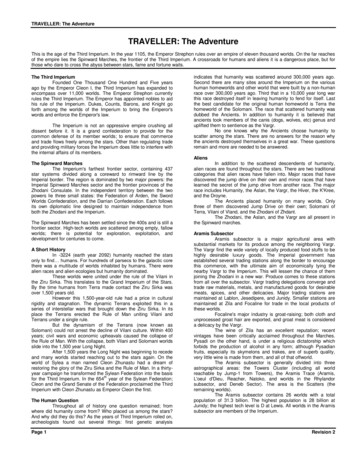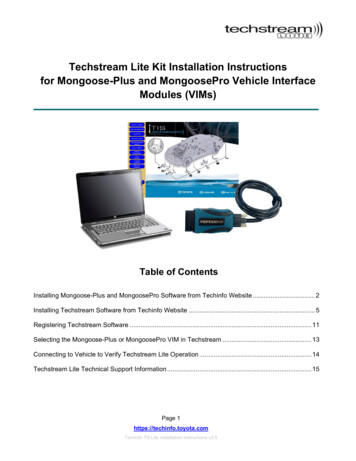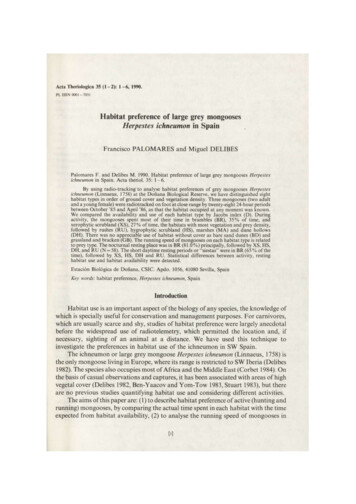
Transcription
Mongoose traveller 2e pdf download full movies
Mongoose traveller 2e pdf download full moviesFREE UK shipping over 100 or over 150 to USFree PDF with every book purchase Games from Mongoose Publishing are always well supported with additional materials that bring your gaming experiences to life. From this page, you can freely download many new game aids, from character sheets to entire ship catalogues of deck plans! CoreRulebook Update 2022 Notes Download link Tweaks and changes to Core Rulebook Update 2022 Download (655 KB) Ship Record Sheet The ship record sheet from Core Rulebook Update 2022 Download (288 KB) A character sheet for Core Rulebook Update 2022 Download (654 KB) Notes Download link An official update to the Core RulebookDownload (536 KB) Character Sheet The official character sheet for Traveller Download (379 KB) The official fully editable character sheet for Traveller Download (372 KB) 2D Deck Plans All the Core Rulebook ships rendered as 2D Deck Plans Download (932 KB) Subsector Map A blank subsector map, ready for your own adventure Download(4.04 MB) Sector Map A whole sector map, completely blank, ready to be explored Download (5.19 MB) Notes Download link Robot Worksheets Handy worksheets to help build your own robots Download (515 KB) Excel Worksheets Comprehensive Excel worksheets to design robots Download (141 KB) Notes Download link All the High Guard shipsrendered as 2D Deck Plans Download (4.6 MB) Ship Roster Sheet Blank Ship Roster Sheet for your own creations! Download (72 KB) Fleet Combat Roster for your largest battles Download (41 KB) Rift Adventure 3: Flatlined Notes Download link An MP3 audio intro for the adventure. By Gavin Russell (SquawksHead), music 'Reloaded' by SavfkDownload (5.7 MB) Notes Download link All the handouts needed for this campaign Download (197 KB) Library Data A handy booklet for Travellers containing the Library Data for this campaign Download (402 KB) Notes Download link A black and white roster sheet for your own vehicles Download 42 KB) Vehicle Roster Sheet A colour roster sheetfor your own vehicles Download (399 KB) Notes Download link An editable/fillable Traveller sheet for 2300AD Download (1.3 MB) Paranoia Notes Download link The official fully editable character sheet for Paranoia Download (573 KB) Free shippingFree UK & US shipping on orders over 100 or 150 FREE PDFWith every book purchase get aFREE PDF to download Secure paymentYour payment information is processed securely. Contact usNeed to contact us? Just send us an e-mail at sales@mongoosepublishing.com C o r e R u l e b o o k Credits Contents Classic Traveller Introduction 2 tRAVELLER cREATION 7 Marc Miller Mongoose Traveller Author Matthew Sprange Original CoreMechanics and Sindal Gareth Hanrahan Skills and Tasks 56 Combat 70 Encounters and Dangers 76 Equipment 91 Vehicles 130 Shawn Driscoll, Gareth Hanrahan, Dale C. McCoy Jr Spacecraft Operations 142 Layout and Graphic Design Space Combat 154 Will Chapman and Amy Perrett Common Spacecraft 164 Interior Illustrations Psionics 196Trade 206 World and Universe Creation 214 The Sindal SubSector 230 Alien Animals Amy Perrett, Biagio D'alessandro, James Gammell, Per Sjögren, Sandrine Thirache, Sara Forlenza, Shen Fei Special Thanks Marc Miller, Rob Eaglestone, Don McKinney, Colin Dunn, Andrew James Alan Welty Playtesters Simon Bell, Alan Buckmaster, ScottyDiamond, Shawn Driscoll, Alex Greene, John Griffiths, Katrina Hepburn, William F. Hostman, Jason 'Flynn' Kemp, Donavan Lambertus, Dale C. McCoy Jr., Andy McMillan, Amy Perrett, Richard Ricker, Ian Stead, Sandrine Thirache, John Watts, Edward Wheeler, James Wilcox, Sam Wissa & Apotheosis, and the Digital Arc Systems Crew (DinaNovitskaya, Lori Golder, Noah Ternullo, Fred Golder) Traveller 2016 Mongoose Publishing. All rights reserved. Reproduction of this work by any means without the written permission of the publisher is expressly forbidden. All significant characters, names, places, items, art and text herein are copyrighted by Mongoose Publishing. This gameproduct contains no Open Game Content. No portion of this work may be reproduced in any form without written permission. To learn more about the Open Game License, please go to www.mongoosepublishing. com. This material is protected under the copyright laws of the United Kingdom and of the United States. This product is a work of fiction.Any similarity to actual people, organisations, places or events is purely coincidental. Traveller is a trademark of Far Future Enterprises and is used under licence. 1 t r a v e l l e r Introduction Traveller is a science fiction roleplaying game of the far future. A multitude of universes await players and you will find Traveller is capable of handling almostany kind of science fiction setting, from highly intricate cyberpunk worlds to campaigns spanning entire galaxies where mighty empires clash and suns explode. Traveller. These Travellers are the central protagonists of the game and scenarios revolve around their adventures and actions. If you have a favourite science fiction film or TV show,Traveller will be able to replicate it for you, bringing your best-loved futuristic moments to your tabletop. Throughout this rulebook, the terms player and Traveller are synonymous. The term character is used to describe those in the game controlled by the referee rather than the players – what are often called non-player characters. However, rulesthat apply to Travellers are usually applicable to characters and vice versa. The Third Imperium The Referee While Traveller is intended to be used for any science fiction setting its players devise, the longest running commercially available universe (indeed, one of the oldest roleplaying game settings of all) is the Third Imperium. Humanity has goneto the stars and found them crowded with other forms of life and other sentient races, and science and technology have advanced vastly over the present day – but the essential nature of humanity is unchanged. Life continues as it does today, only spread out over the sea of stars. A mighty Imperium unites thousands of star systems under a singlerule, but it is beset by enemies both internal and external. The Imperium commands the space between the stars, ensuring that civilisation endures and trade continues. Megacorporations and feudal lords conduct the bulk of this trade, but there will always be a place for the free trader – hardy travellers and adventurers on the fringes of ChartedSpace, dealing in strange goods and smuggled cargoes, doing whatever they can to make a credit. While the Traveller rules can be used to model almost any science fiction novel, movie or setting, the traditional setting for games is the Third Imperium of Mankind, the third great empire to stretch across the stars. In the Third Imperium setting, theplayers take on the roles of tramp merchants and mercenaries, wandering the galaxy in search of profit and adventure. Players and Travellers Most of the participants in a Traveller game will be players. Usually, each player generates a character using the Traveller Creation rules; that character becomes the player’s avatar in the game world and iscalled a One of the participants is the referee, who describes the world around the Travellers, presents them with challenges and dangers, and takes on the role of the supporting cast and the antagonists. The referee creates the basic outline of the scenarios that the Travellers encounter and resolves the results of their actions using the rules in thisbook as a guideline. Scenarios and Campaigns In a scenario, the Travellers embark on a journey or adventure overseen by the referee. The referee determines what dangers the Travellers will face, from Traveller Rule Zero Many roleplaying games have a ‘rule zero’ which marks out a referee’s fiat, the notion that the referee is free to ignore orchange any rule to fit in with his campaign. This is true of Traveller as well, but it is worth making a special note about this game. Traveller comprises several ‘mini-games’ such as world creation, trade, and character creation that allows much of the game to run on ‘autopilot’. In many circumstances, the referee is able to make a few rolls on a fewtables and generate characters, battles, even a sizeable part of the known universe – this is great news for the busy referee who can then concentrate on the adventure. However, while these tools are in place, the referee should never feel bound by them and has the latitude to ignore any generated results in preference to his own creations. hostilealiens or criminals to solar flares or automated defence systems, or even political intrigue and deception. The Travellers choose how their characters will react and overcome these obstacles. For example, the Travellers may be hired to bring a cargo from one world to another, but a rival merchant is trying to stop them and has hired a band ofmercenaries to attack the Travellers’ ship en route. The Travellers have to get the cargo through safely. A scenario can be a one-off game, using Travellers created by the referee specifically for that game and discarded afterwards, or it can be part of a campaign. A scenario takes one or more game sessions to complete. A campaign is a series ofscenarios, charting the continuing adventures of a group of Travellers, and is the most common form of Traveller – mainly because it is the most fun and rewarding! A campaign can be continuous or episodic. In a continuous campaign, each scenario follows on almost immediately from the end of the last one and the fuel, resources and moneyavailable to the Travellers is carefully tracked. In an episodic game, there are longer gaps between scenarios, and the game focuses only on the exciting and conflict-filled parts of the Travellers’ lives. Campaign Ideas A few suggestions to get the ball rolling: The Trader Campaign: The Travellers form the crew of a free trader merchant vessel, takingwhatever cargoes they can get to keep their spacecraft aloft and in one piece. Inspiration for games like this could be the TV series Firefly or computer games such as Elite and Privateer. The Military Campaign: The Travellers are all members of a military unit, usually veterans of similar careers or leaders of a mercenary unit. They participate incampaigns, skirmishes and other military activity. Inspiration could come from the Honor Harrington novels, the film Aliens, or Starship Troopers – the book, animated series or film. The Explorer Campaign: In a game of this type the Travellers go beyond the borders of Charted Space, looking for objects, planets and civilisations of value or curiosity.The Travellers will have to be highly self-sufficient to survive on their own for long stretches. For inspiration look no further than the original series of Star Trek. 3 The Traveller Campaign: The traditional Traveller campaign features a little of everything. The Travellers will go from exploring abandoned alien ziggurats to rescuing missing pets totaking on the local crime lord in a protracted gang war. Inspiration could come from anywhere. Further Reading Throughout this book, mention is made of other titles available in the Traveller series. Each of these books concentrates on a particular aspect of Traveller, allowing you to expand your game into new realms of play. However, none arevital or necessary to the game and are presented only for your continued enjoyment – you can explore a huge amount of the galaxy with this Core Rulebook alone! The other titles mentioned in this book include: The Traveller Companion: Space is big, and there was only so much we could squeeze into the pages of the Traveller Core Rulebook. Now,for the first time, our 4 writers are truly given free reign to explore all aspects of science fiction through the Traveller Companion, a book dedicated to alternative methods of play, differing technologies and the experimentation of expanded genres. From warp drives to alternate career creation, the Traveller Companion is a massive toolkit allowingyou to tailor your campaign to exactly how you want it. High Guard: For campaigns that include a great amount of space travel, High Guard is invaluable. Including a complete spacecraft design system, this book allows players and referees to create their own ships from scratch or customise those already designed. As well as featuring a veritablefleet of new ships, High Guard also introduces a brand new scale of combat – Capital scale, where giant dreadnoughts and battleships clash across entire star systems. Tour of the Imperium: From the heart of Capital to the furthest reaches of the Spinward Marches, Tour of the Imperium is your entry to the Third Imperium universe, one of the oldestand most celebrated settings of any roleplaying game. Follow the journeys of a variety of ships as you explore the Imperium from the perspective of the greatest nobles to the seediest underside of the criminal underclass. Central Supply Catalogue: This book contains all manner of unique items that no self-respecting Traveller should be without.Whether you are looking for a more powerful weapon, sophisticated bugging equipment or the finest in evening wear, this book has it all. Neatly divided into easy to find sections, the Central Supply Catalogue greatly expands the range of equipment and tools available to players. The Vehicle Handbook: This book contains a complete constructionsystem allowing you to build any vehicle from any universe, from a simple bicycle to advanced power armour, from a floating aircraft carrier to a massive piloted robot. Full rules are also given to completely customise your vehicles and a huge number of ready built designs are included to expand your campaigns. Game Conventions A quick discussionof terminology and conventions is needed before proceeding. Understanding this section will make your comprehension of the rest of the rulebook much quicker. Traveller uses two six-sided dice to resolve most actions. Some situations involve fewer or more dice. 1D/2D: To avoid writing ‘roll two six-sided dice and add them together’ over and overagain, Traveller uses the abbreviation ‘roll 2D’. Where you see ‘roll 2D’ read ‘roll two six-sided dice and add them together’. Sometimes you may also see ‘1D’, ‘3D’ or other numbers of ‘D’. This simply means roll one six-sided die, three six-sided dice, or however many six-sided dice are indicated, and add them together to gain the final result.2D 3/3D-2: If an addition or subtraction appears after the normal dice abbreviation, that simply means add or subtract the number shown. So, for example, 2D 3 means ‘roll two dice, add them together, and then add three’. D3: Occasionally, you may see a reference to D3. This means we treat the dice as if they have only three sides each, by dividingthe number rolled by two and rounding upwards. So, a roll of 1-2 means one, a roll of 3-4 means two, and a roll of 5-6 means three. If a number appears before the ‘D’ (such as 2D3, for example), this means roll two dice and divide the results of both by two before adding them together. D66: This is shorthand for a special way of rolling two six-sideddice. Before rolling nominate one die as the ‘tens’ die and one as the ‘units’ die, to give you a two-digit number between 11 and 66. Some numbers cannot be rolled on a d66 (any number with a 7 or higher in it), giving you a total of 36 possible outcomes. Rolls: To determine if a Traveller succeeds or fails at a particular task, you must make a roll. Aroll is always done by rolling 2D and adding any appropriate Dice Modifiers. If the total is equal to or greater than the target number for that roll, he succeeds. The target number for a roll will always be listed in its description. For example, you may be asked to roll for STR 10 . This would mean roll two dice, add your Strength modifier and get 10 ormore to succeed. Checks: A check is exactly the same as a roll but the Dice Modifier will always be a characteristic or skill. Thus, you will be asked for a characteristic check or skill check. For most characteristic or skill checks, you will need to get an 8 or more after all Dice Modifiers have been applied in order to succeed. Natural 2/Natural 12: Somerolls refer to a ‘natural’ number – this is the actual number rolled on the dice before any modifiers are applied. Dice Modifier (DM): A number to be applied to a dice roll before it is used. Dice Modifiers are always followed by a sign, which indicates if the number is to be added to or subtracted from the roll. For example, DM-2 indicates that two is tobe subtracted from the roll; DM 4 indicates that four is to be added to the roll. Rounding: Unless otherwise stated, whenever you are asked to divide in Traveller, always round down. Technology Levels The concept of Technology Levels (Tech Level or TL) runs through Traveller in most of its settings. Technology Levels measure the scientific capacityof a world and the complexity and effectiveness of a piece of equipment. The Technology Level scale starts at 0. In the Third Imperium setting, the most advanced scientists are probing the upper boundaries of TL 15, but most core worlds range between 10 and 13. Out on the fringes of the Imperium in sectors like the Spinward Marches or TrojanReach, Technology Levels vary wildly. Isolated systems visited only once or twice a generation might have slipped back into the darkness, losing technology 5 to war or disaster. On other worlds, secret research bases, isolationist colonies or Ancient relics hold scientific secrets of vast worth. Even on a low-technology world, there might be examples ofhigher technology. A warlord on a primitive planet might enforce his rule with advanced weapons imported from offworld; colony worlds are often dependent on their sponsor civilisation for supplies and support. Some low-technology worlds are aware of the larger universe, and have consciously decided to reject higher technology. TL 0 (Primitive):No technology. TL 0 species have only discovered the simplest tools and principles, and are on a par with Earth’s Stone Age. TL 1 (Primitive): Roughly on a par with Bronze or Iron age technology. TL 1 science is mostly superstition, but they can manufacture weapons and work metals. TL 2 (Primitive): Renaissance technology. TL 2 brings with it agreater understanding of chemistry, physics, biology and astronomy as well as the scientific method. TL 3 (Primitive): The advances of TL 2 are now applied, bringing the germ of industrial revolution and steam power. Primitive firearms now dominate the battlefield. This is roughly comparable to the early 19th century. TL 4 (Industrial): The transitionto industrial revolution is complete, bringing plastics, radio and other such inventions. Roughly comparable to the late 19th/early 20th century. TL 5 (Industrial): TL 5 brings widespread electrification, tele-communications and internal combustion. At the high end of the TL, atomics and primitive computing appear. Roughly on a par with the mid–20thcentury. TL 6 (Industrial): TL 6 brings the development of fission power and more advanced computing. Advances in materials technology and rocketry bring about the dawn of the space age. TL 7 (Pre-Stellar): A pre-stellar society can reach orbit reliably and has telecommunications satellites. Computers become common. At the time of writing,humanity is currently somewhere between TL 7 and TL 8. TL 8 (Pre-Stellar): At TL 8, it is possible to reach other worlds in the same system, although terraforming or full colonisation are not within the culture’s capacity. Permanent space habitats become possible. Fusion power becomes commercially viable. TL 9 (Pre-Stellar): The defining element ofTL 9 is the development of gravity manipulation, which makes space travel vastly safer and faster. This research leads to development of the jump drive, which occurs near the end of this Tech Level. TL 9 cultures can colonise other worlds, although travelling to a colony is often a one-way trip. 6 TL 10 (Early Stellar): With the advent of commonlyavailable jump drives, nearby systems are opened up. Orbital habitats and factories become common. Interstellar travel and trade lead to an economic boom. Colonies become much more viable. TL 11 (Early Stellar): The first true artificial intelligences become possible, as computers are able to model synaptic networks. Grav-supported structuresreach to the heavens. Jump 2 travel becomes possible, allowing easier travel beyond the one jump stellar mains. TL 12 (Average Stellar): Weather control revolutionises terraforming and agriculture. Man-portable plasma weapons and carrier-mounted fusion guns make the battlefield untenable for unarmoured combatants. Jump 3 travel is developed.TL 13 (Average Stellar): The battle dress appears on the battlefield in response to the new weapons. Cloning of body parts becomes easy. Advances in hull design and thruster plates means that spacecraft can easily go underwater. Jump 4 travel. TL 14 (Average Stellar): Fusion weapons become manportable. Flying cities appear. Jump 5 travel. TL 15(High Stellar): Black globe generators suggest a new direction for defensive technologies, while the development of synthetic anagathics means that the human lifespan is now vastly increased. Jump 6 travel. Higher Technology Levels exist (indeed, there is no theoretical upper limit) and may appear in other settings or be discovered by pioneeringscientists within the Third Imperium. C h a p t e r - O n e tRAVELLER cREATION Traveller uses a unique method to create characters ready for play. Instead of choosing a class and various skills or abilities, in Traveller you start off as a brighteyed 18 year old with the whole universe at your feet. You will then decide what kind of career you mightwant to engage in and then watch as your Traveller’s life unfolds – very possibly in a completely different direction! When you have finished this process, you will be ready for play with a Traveller who has history and a full career (successful or otherwise) behind him. They will now be ready for the next phase of their life, one full of excitement andadventure It should be noted that there are no ‘super’ characters in Traveller. This game is very much based around the idea of putting ordinary people in extraordinary situations, and of playing with the cards that the universe has dealt to you. Be ready to make the best of what you get – much like real life (though real life tends to lack starships,exploding suns and eight foot tall intelligent lion-like aliens). So, another player may end up with a battle-hardened marine who can shoot out a fox’s eye at a hundred paces with any weapon in Charted Space, but your failed rock star who never managed to get anywhere in his career may well have more to contribute to the group. After all, not everyproblem can be solved with a gun. In fact, in Traveller, a gun may cause more issues than it solves. Creation Summary A Traveller’s abilities and skills are determined by their training and past experience. Traveller creation begins with rolling characteristics, six values that describe your initial physical and mental capabilities. After determiningcharacteristics and a few background skills from adolescent life, it is time to embark on a career. Each Traveller goes through one or more four-year career terms, which grant various skills and benefits. There are risks associated with each career – serving a tour of duty in the Imperial Marines may give a Traveller a good grounding in combat andweapons use, but there is always the risk of injury in battle. A term spent in a corporation is unlikely Group Creation It is common in roleplaying games for players to create their characters before play begins, so everyone turns up on the first day of a campaign ready to go. It is rare for us to say this but, in Traveller, this is the Wrong Thing to do.Traveller creation is intended as a group activity, partly because of the Connections Rule but also because it was specifically designed to be done within a group activity, with players able to see how one another’s Travellers are progressing and get a deeper understanding of what they were doing before the campaign begins. So, treat Travellercreation as a kind of ‘mini’ game that takes place in the first session of every new campaign. Your enjoyment of Traveller will increase greatly, we promise you! to get the Traveller injured or killed, but will not usually provide skills valuable in combat. In addition to skills, Travellers pick up benefits such as cash, equipment, or contacts from a career.However, there are limits on how many career terms a Traveller can go through – the risks of aging or injury mount up over time, and some Travellers will move between two or three careers in their lives. At some point, you will decide to leave your career for a new life of adventure before your Traveller gets too old. While going through a career, youcan establish ties between your Traveller and those of the other players, so everyone will be old friends (or rivals!) before play begins. You will also be able to pick a campaign package after everyone has finished creating their Travellers, which will allow you to fill any gaps in the group’s skill range. Basic Traveller generation should be done by allplayers at the same time as a group activity, going through each term together. For alternate forms of Traveller creation such as point allocation systems, consult the Traveller Companion. Characteristics Every person and creature in Traveller has several characteristics that describe their base mental and physical potential. The basic characteristicsfor humans are shown opposite. Rolling Characteristics To determine your Traveller’s characteristics, roll 2D one after another, and assign the scores in any order you wish to the six characteristics, starting with Strength. Record them on your character sheet. For each characteristic, determine its Dice Modifier on the Characteristic Modifier tablebelow. Characteristic Modifiers Characteristic Score 0 1-2 3-5 6-8 9-11 12-14 15 Dice Modifier -3 -2 -1 0 1 2 3 Physical Characteristics Strength (STR): A Traveller’s physical strength, fitness and forcefulness. Dexterity (DEX): Physical co-ordination and agility, reflexes. Endurance (END): A Traveller’s stamina, determination and ability tosustain damage. Mental Characteristics Intellect (INT): A Traveller’s intelligence and quickness of mind. Education (EDU): A measure of a Traveller’s learning and experience. Social Standing (SOC): A Traveller’s place in society. At this point, you are eighteen years old and ready to take on the universe! Throughout your career, you may find yourcharacteristics change. The maximum score for a characteristic is 15 for an unaugmented human character. There are exceptions to this, but they will be covered later for specific rules and circumstances. Skills Skills are the most important aspect of a Traveller, and are discussed in detail on page 56. A Traveller’s proficiency in any skill is denoted bytheir level in that skill. Background Skills Before embarking on your careers, you receive a number of background skills equal to your Education DM 3 (so, 0 to 6, depending on your Education score), chosen from the list below. This represents the knowledge you have picked up during adolescence and will allow you to function at a basic level in atechnological society. Admin 0 Animals 0 Art 0 Athletics 0 Carouse 0 Drive 0 8 Electronics 0 Flyer 0 Language 0 Mechanic 0 Medic 0 Profession 0 Science 0 Seafarer 0 Streetwise 0 Survival 0 Vacc Suit 0 Where do I Come From? While knowledge of a Traveller’s homeworld is not necessary, it is a very nice tool to start shaping the character of onefrom the outset. Background skills can be picked to help suggest the kind of world the Traveller grew up on. For example, a Traveller coming from a naturalistic, agricultural world may well have Animals, Seafarer and Survival skills, whereas one whose childhood was spent in an asteroid belt would likely have Vacc Suit, Electronics and Flyer,representing a life in space surrounded by high technology. This is by no means compulsory, but you may find the Traveller you create starts to come alive much faster during creation. Careers Next, your Traveller engages in one or more career terms, representing their previous experiences and adventures before the start of the campaign. Eachcareer term lasts for four years, even if a Traveller fails a Survival roll or is forced to leave a career. At many points during a career, a Traveller will have to make a dice roll of some sort. Most of these rolls are based on characteristics – simply roll 2D, add the DM from the listed characteristic, and try to get a total higher than or equal to the listedvalue. So, a roll of INT 8 means ‘roll 2D, add your Intellect DM, and you succeed if you roll an 8 or more’. A few rolls are skill checks, where you add any levels in that skill. For example, a roll of Gunner 8 would mean ‘roll 2D, add your Gunner skill level, and get 8 or more to succeed’. Note that later in the rules, you are able to add furthermodifiers to checks like this (for example, when using the Gunner skill to shoot, you can often add your DEX DM). However, these other modifiers are never applied during character creation. In each career, there are three assignments, representing different aspects of the career. Pick one of these assignments when you enter the career. SocialStanding and Nobility Travellers with a high Social Standing are the cream of their civilisations and may be very well known on their world and possibly across vast swathes of Charted Space. However, while the Third Imperium maintains a system of nobility that is recognised across most of its worlds, not everyone with a high Social Standingnecessarily has a noble title – or is even a noble at all. Nobles of very high ran
FREE UK shipping over 100 or over 150 to USFree PDF with every book purchase Games from Mongoose Publishing are always well supported with additional materials that bring your gaming experiences to life. . , or Starship Troopers - the book, animated series or film. The Explorer Campaign: In a game of this type the Travellers go beyond .










